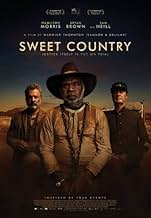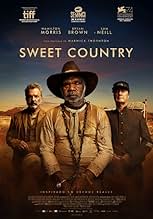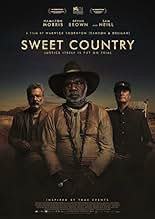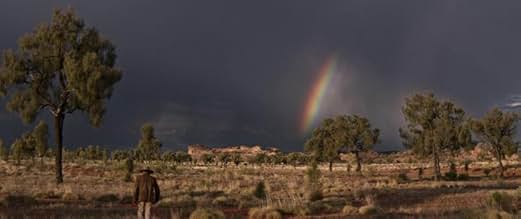Dieser australische Western spielt in den 1920er Jahren an der Grenze zum Northern Territory, wo die Gerechtigkeit selbst vor Gericht gestellt wird, als ein alter Aborigine-Landarbeiter eine... Alles lesenDieser australische Western spielt in den 1920er Jahren an der Grenze zum Northern Territory, wo die Gerechtigkeit selbst vor Gericht gestellt wird, als ein alter Aborigine-Landarbeiter einen weißen Mann aus Notwehr erschießt, flieht und daraufhin gnadenlos gehetzt wird.Dieser australische Western spielt in den 1920er Jahren an der Grenze zum Northern Territory, wo die Gerechtigkeit selbst vor Gericht gestellt wird, als ein alter Aborigine-Landarbeiter einen weißen Mann aus Notwehr erschießt, flieht und daraufhin gnadenlos gehetzt wird.
- Regie
- Drehbuch
- Hauptbesetzung
- Auszeichnungen
- 22 Gewinne & 29 Nominierungen insgesamt
- Lizzie
- (as Natassia Gorey-Furber)
- Olive
- (as Luka May Glynn-Cole)
- Constable Campbell
- (as Lachlan Modrzynski)
Empfohlene Bewertungen
Set in 1920s outback Northern Territory, the narrative is deceptively simple. Indigenous farm hand Sam Kelly (Hamilton Morris) and his wife are lucky to work for god-fearing landowner Fred Smith (Sam Neill) who believes that all are created equal. Fred allows Sam to help his unstable war-veteran neighbour Harry March (Ewan Leslie) for a few days but it sours quickly and Sam kills Harry in self-defence. The rest of the story tracks the hunt led by Sergeant Fletcher (Bryan Brown) through treacherous country that is home for Sam. Eventually white man's justice must be faced.
This is an outstanding film for many reasons. In terms of visual impact, it is stunning. The cinematography shows a deep love of country with majestic panoramas that dwarf humans. Rich red colour palettes evoke the hot, dry, heartland of an ancient land. The camera tracks seamlessly from wide-screen images to small details like a balletic sand scorpion or a cold hard bullet being loaded into a chamber. Scene after scene, we find symbols of the conflicted relationship between white man and nature; there are no words more jarring than to hear Indigenous people being referred to as "black stock".
In terms of aural impact, silence has never been so beautiful. It takes some time into the film before we notice there is no musical score, and none is needed. As Thornton put it, when you stand in the desert there are no orchestral violins to tell you what to feel. Silence conveys the outback. You hear the rustle of leaves in the wind, the sound of a flowing river, horses' hooves pounding the ground, and most confronting: the sound of a heavy chain being dragged across desert sand, manacled to the black hand of a fleeing Indigenous youth.
The casting is excellent. Bryan Brown and Sam Neill are almost cameo performers in their roles as hard-core outback characters. The emotional centre of the film, however, is Hamilton Morris. He speaks little and emotes even less. His face is a wide, impassive, deeply etched, and painful canvas that speaks of Indigenous people's dispossession and barbaric mistreatment by armed invaders. Views will differ over whether the Johnny Cash cowboy ballad during the credits makes this more or less of an Australian story. This powerful but disturbing film reminds Australians of our history and need to reconcile with the past.
So lets speak about other aspects of the film: cinematography, acting and story telling are superb. But I liked most of all the editing, with these tiny flashes forward and backward throughout the movie, flashes we can fully understand only when we've seen the movie all the way through. Please do, I think you won't regret it.
Both haunting and tragic, the film is politically provocative and poetically proverbial in narrating a dark era when Australia's justice system was still in its infancy. On the run for killing a cruel white settler, Aboriginal Sam (Hamilton Morris) and his wife have little chance of escaping the law, especially during a time when lawmakers were the laugh of the town. It doesn't help either that a frontier soldier (played by Bryan Brown) is out for blood as a self- proclaimed lawman. Sam's only aid is his charitable employer and preacher Fred (Sam Neil). But there's something about the whole incident that Sam and his wife have kept to themselves and the only way for any sliver of redemption is to get caught.
Although deliberately paced (the very first scene is a symbolic pot on the boil), the final showdown is suspenseful but also gut- wrenching and ultimately heartbreaking. An Aboriginal himself, Thornton (who is also the cinematographer) uses gorgeous vistas of the Australian landscape to juxtapose the ugly nature of this story with the sheer beauty of his land. And amongst all this beauty there is suffering, trauma, barbaric colonialism, and absolute disregard for human life. As impressive as the visuals is Thornton's meticulously composed storytelling and it's a power structure with imposing breath, width and emotional depth.
Wusstest du schon
- WissenswertesThe film is based on a real life true crime murder case where an Aboriginal man was arrested and put on trial for murdering a white man in central Australia during the 1920s.
- PatzerUnder Australian law, an execution would not be carried out immediately (or the next day), as executions would need to be confirmed by the State Governor. There also be time allowed for appeals against the death sentence.
- Zitate
Fred Smith: We're all equal here. We're all equal in the eyes of the Lord.
- VerbindungenFeatured in Sweet Country: Behind the Scenes (2018)
- SoundtracksDown at Long Point
Written and Performed by Damien Lane
Top-Auswahl
- How long is Sweet Country?Powered by Alexa
Details
Box Office
- Bruttoertrag in den USA und Kanada
- 104.297 $
- Eröffnungswochenende in den USA und in Kanada
- 8.895 $
- 8. Apr. 2018
- Weltweiter Bruttoertrag
- 1.810.021 $
- Laufzeit1 Stunde 53 Minuten
- Farbe
- Sound-Mix
- Seitenverhältnis
- 2.35 : 1
Zu dieser Seite beitragen
































